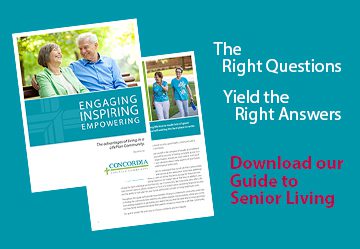
Why “When Something Happens” is Too Late: Choosing the Best Living Options for Senior Couples in Need of Additional Care
One of the more difficult decisions couples face is deciding where to turn when one spouse is still able to maintain an independent living lifestyle but the other is experiencing health issues that require additional support.
The choice typically comes down to two options: bring in home health, or find a new living option that can assist the spouse in need while supporting the independence of the other.
Whether you are the healthy spouse or the adult child in the matter, it is normal to feel mixed emotions and even “caregiver’s guilt” in making the right choice.
If the couple’s plan is to stay together in the same home environment for as long as possible, it’s important to make the decision before an incident occurs or illness overwhelms. Waiting until “When Something Happens” – a fall, a heart attack – will radically decrease a couple’s ability to live together as one.
At Concordia Life Care Community, we know that the decision to leave your familiar surroundings and move into a senior living community is a difficult one, particularly when one spouse remains independent. And there are certainly times when at-home care can suffice. We’ve known many couples in similar situations, and have developed tips to help guide you on making the best choice for your needs.
Tip #1: Know the signs around the house.
Caregiving takes a toll on the caregiver. Inevitably, issues start to pop up in a home where one spouse is in need of support. If you are experiencing any of the following, it may be time to consider a change.
- When you rely more on others. If neighbors are pitching in more, or family members are stopping by more often, it could be a sign that your independence is changing.
- When transportation becomes a chore. Health issues lead to doctor’s appointments, so the ill spouse is often reliant on the healthy partner or other caregiver to get to and from medical visits (not to mention visits to the grocery store, salon, post office and other needs). Transport might also involve physically lifting the individual into or out of the car.
- When “cooking” becomes “reheating.” Overwhelming caregiving puts convenience before nutrition, so at meal times, foods are often reheated instead of prepared from scratch. Though simple to make, frozen foods can contain high amounts of sodium and unhealthy ingredients, which lead to complications like heart disease, diabetes, or related conditions.
- When you aren’t using the house as normal. Though your home may be familiar, how much of its square footage is actually being used? Perhaps only the bedroom, the living room, one of the bathrooms, and a kitchen. The rest remains empty. And don’t forget the yard work.
There are also illness-specific issues. For example, a spouse with dementia or Alzheimer’s may display symptoms like aggression or wandering that require care as soon as possible. Inevitably, these issues can lead to an incident that limits the decision-making and independence of both spouses.
Tip #2: Know your support options.
Depending on the level of need, there are a variety of assistance levels available.
Home nursing
Many couples start with a regular visit from a nurse to assist the spouse in need with medication and device management, grooming, health assessments, and more. (Non-medical support is also available to provide transportation, home maintenance, or cooking).
At-home nursing can ease the burden of caregiving on the independent spouse and family members. Costs are typically paid out of pocket unless Medicare coverage is available due to a medical episode.
There are downsides to at-home care. The nurse may not be the same individual for each visit, meaning unfamiliar faces around the house. Other times, the nurse may show up late or, as happens in one’s job, take a sick day or have to deal with a personal issue that prevents them from providing assistance.
For individuals with mobility issues, most homes lack handicap-friendly access. To make a home compliant to individuals with disabilities requires the expense of widening doors, adding ramps, or installing roll-in/roll-out showers and handles in the bathroom. Such additions can cost thousands and wind up decreasing the resale value of the home.
Short-term rehabilitation
For spouses on the mend from a surgery, illness, or a fall or accident, short-term rehabilitation is available, giving individuals time to recuperate before going back home. At-home care may be required afterward. As the name implies, short-term rehab is not a long-term fix.
Stand-alone Assisted Living communities
Some communities specialize only in Assisted Living (and sometimes provide memory care for dementia or Alzheimer’s patients), offering a permanent home and 24/7 support to residents. The healthy spouse has a choice of living at their home and making visits, or moving into the assisted living community. If the healthy partner chooses to live at the community, he or she may feel limited, as these neighborhoods do not contain the same level of amenities found in a Continuing Care Retirement Community.
Continuing Care Retirement Community (CCRC)
The best solution for couples where one spouse is healthy and the other has a chronic illness is a Continuing Retirement Community, also known as a CCRC. These all-inclusive, maintenance-free communities offer independent living with a variety of amenities, plus the built-in support of health care services as residents’ needs change including assisted living, memory care, and skilled nursing. The couple can also live together in the same apartment or home and receive the appropriate level of care.
A Continuing Care Retirement Community also offers a range of activities, social events, and educational opportunities for all residents. These communities include an on-site health center staffed by physicians, nurses, and specialists, and sometimes maintain an affiliation with a nearby hospital or healthcare network, providing fast access to centers and treatment for specific illnesses such as cancer, heart disease, diabetes, Parkinson’s and more.
Living space options at retirement communities may include apartments in a large main building, or stand-alone patio homes. The community is designed to be handicap friendly with roll-in/roll-out showers, automatic doors, widened hallways and doors, and emergency call buttons. Best of all, the entire campus – inside and out – is designed to provide opportunities that promote an active lifestyle and sense of purpose.
Tip #3: Know the cost considerations.
There is no one-size-fits-all when it comes to cost.
Assisted Living and Continuing Care Retirement Communities typically require an upfront entrance fee. In addition, residents are charged a monthly service fee that covers their home, meals, amenities and services. The cost of long-term care will vary depending on the community chosen and the type of services provided. Depending on the contract, costs at a Continuing Retirement Community may fluctuate based on the level of support needed. A Life Care contract, like what Concordia offers, provides predictable costs, no matter the level of support needed.
Various financial options are available to help cover the cost of senior care, like long-term care insurance and Medicare. Be sure to review and understand the financial commitment required.
+++
Though there are at-home options available, a Continuing Care Retirement Community provides a full spectrum of amenities with peace of mind knowing that health care support is just around the corner – or a push-of-a-button away.
Waiting until a crisis occurs to make a decision will dramatically limit a couple’s living options and ability to live together as one. Make the decision to keep as much independence as possible while getting the necessary support to the spouse in need.
Health & Aging


